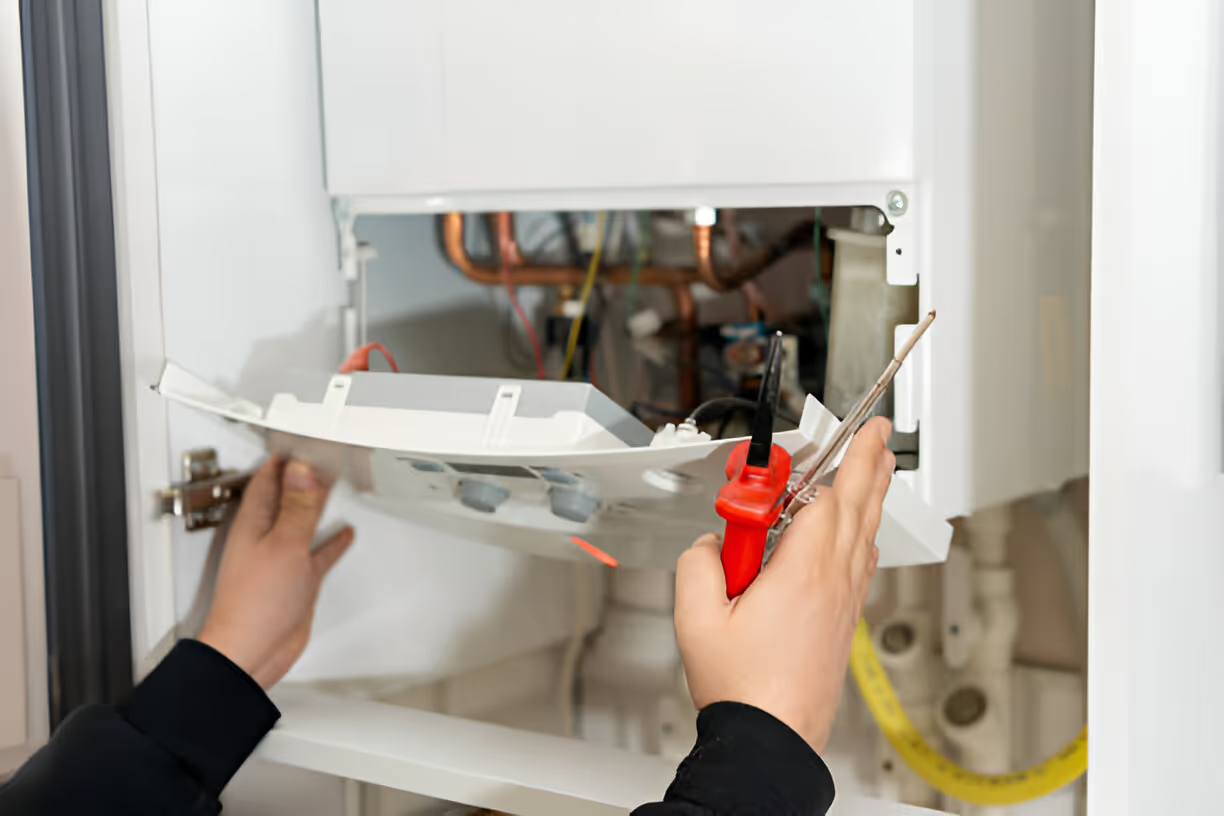Gas Furnace Maintenance in Fountain Hills, AZ
A properly maintained gas furnace protects your home, family, and comfort. In Fountain Hills, AZ, seasonal temperature swings, desert dust, and monsoon storms create specific stresses on gas heating systems that make targeted maintenance essential. Routine gas furnace maintenance focuses on safety inspections (gas lines, connections, venting), combustion analysis, heat exchanger integrity, carbon monoxide testing, and proven safety protocols so your system starts reliably and runs efficiently when you need it.

Why specialized gas furnace maintenance matters in Fountain Hills homes
- Fountain Hills’ dry, dusty environment deposits particulate in burners, pilot assemblies, and flame sensors, increasing the risk of incomplete combustion and reduced efficiency.
- Temperature swings between warm days and cool nights put repeated stress on metal components, which can accelerate fatigue or small cracks in heat exchangers.
- Monsoon season can introduce brief humidity and airborne debris that accelerate corrosion in venting and outdoors vent terminations.
- Many homes run the furnace infrequently. Systems that sit idle for months are more likely to have ignition problems or unnoticed gas leaks at first startup.
Because of these local factors, a gas-focused maintenance visit does more than clean filters. It checks for gas safety, proper combustion, vent integrity, and potential carbon monoxide hazards specific to your furnace and installation.
Common gas furnace issues in Fountain Hills
- Dirty burners or clogged orifices causing weak or yellow flames
- Ignition failure or intermittent pilot/igniter operation after long idle periods
- Cracked or corroded heat exchanger leading to dangerous combustion gas leakage
- Blocked or deteriorated venting and flue systems that cause backdrafting
- Loose or leaking gas line connections
- Elevated carbon monoxide from incomplete combustion or venting issues
- Reduced heating capacity and higher natural gas use from poor combustion tuning
What a comprehensive maintenance visit includes
A full gas furnace maintenance service is diagnostic and preventative. Key steps typically performed by certified technicians:
- Visual safety inspection
- Check furnace cabinet, burners, gas piping, and nearby clearances for signs of rust, corrosion, or physical damage
- Verify vent termination and combustion air openings are clear of nests, debris, or blockage
- Gas line and connection inspection
- Inspect supply piping and fittings for corrosion, loose joints, or damage
- Use gas-leak detection tools to confirm there is no escaping natural gas at connections
- Ignition and safety control checks
- Test electronic ignitor or pilot assembly for consistent ignition
- Inspect flame sensor and clean if needed
- Verify operation of limit switches and safety cutouts
- Combustion analysis
- Use a combustion analyzer to measure oxygen, carbon monoxide, and exhaust temperature at the flue
- Adjust gas pressure and burner settings to meet manufacturer combustion specifications for safe, efficient operation
- Heat exchanger integrity checks
- Conduct a careful visual inspection for warping, cracks, or corrosion
- Check for signs of combustion gas leakage where accessible
- If the technician suspects hidden damage, recommend further diagnostic testing or replacement
- Venting and flue inspection
- Confirm flue pipe condition, proper slope, and secure connections
- Look for rust holes, disconnected sections, or improper materials that can compromise draft
- Carbon monoxide testing
- Measure ambient CO near the furnace and in accessible living areas
- Verify that measured levels are within accepted safety guidelines and that no combustion gases are entering the living space
- System performance review
- Inspect filters and recommend replacement or cleaning
- Test thermostat accuracy and furnace cycling behavior
- Provide notes on efficiency, likely remaining life of key components, and any recommended repairs
How maintenance prevents major repairs and safety risks
- Early detection of small cracks or corrosion in the heat exchanger prevents potentially dangerous flue gas leaks from progressing.
- Correcting combustion tuning reduces wasted gas and lowers monthly heating cost while protecting against carbon monoxide production.
- Clearing burners and maintaining ignitors and safety controls reduces no-heat calls and emergency starts during cold snaps.
- Proper venting inspections prevent backdrafting and ensure exhaust gases are directed safely outdoors.
- Gas line checks reduce the low-probability but high-impact event of a gas leak.
What to expect after service
After maintenance you should notice:
- More reliable starts and fewer ignition delays
- Cleaner, bluer burner flames indicating proper combustion
- Quieter operation and fewer short cycles
- Stable indoor air safety with carbon monoxide levels well within safe ranges
- A written report summarizing findings, combustion readings, and recommended follow-up repairs if any issues were found
Recommended maintenance cadence for Fountain Hills
- Annual gas furnace tune-up, ideally before the first cold period. In Fountain Hills, that often means scheduling in late fall when systems are being turned on after months of inactivity.
- More frequent inspections for older systems or homes with high dust exposure, pets that shed, or nearby construction that increases particulates.
- Immediate service if you detect persistent soot, discolored flame, unusual odors, or any symptoms of CO exposure such as headaches, nausea, or dizziness.
Safety protocols and technician standards
Professional gas furnace maintenance should follow strict safety protocols:
- Shutoff and lockout procedures before working on gas components
- Use of calibrated combustion analyzers and CO detectors
- Gas leak detection prior to and after any adjustments
- Compliance with manufacturer instructions and local codes for venting and clearances
- Clear reporting of safety-critical findings and advice on necessary actions
Final notes on preserving comfort and safety
Gas furnace maintenance in Fountain Hills is about more than comfort during cooler weather. It is a safety inspection, an efficiency tune-up, and a longevity strategy. Regular, gas-specific maintenance protects against the local effects of dust and seasonal stress, reduces the risk of carbon monoxide hazards, and keeps your system running efficiently when you need it most. Prioritize a certified, gas-skilled technician who performs combustion analysis, heat exchanger checks, venting inspection, and CO testing to ensure dependable, safe heating in your home.






